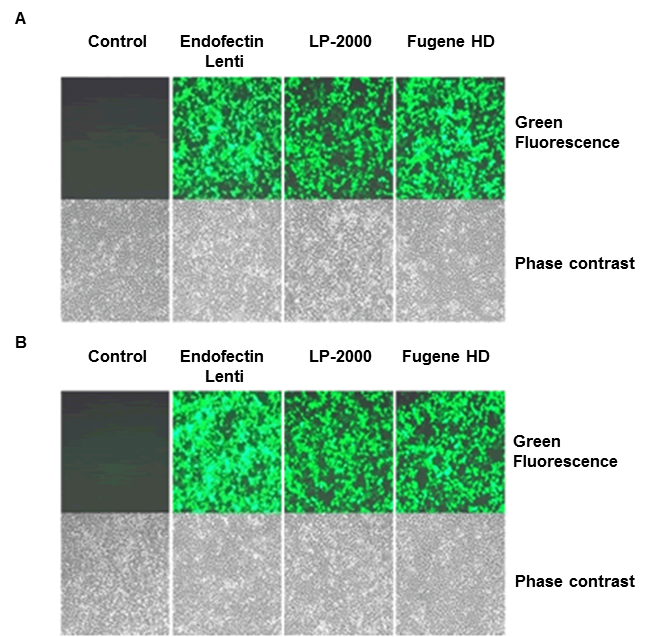A versatile & efficient suite of robust transfection reagents
GeneCopoeia’s EndoFectin™ line of transfection reagents provide affordable and powerful solutions that encompass a range of different applications, from general purpose reagents like EndoFectin™ Max, to the highly-specialized reagent for HepG2 cells, EndoFectin™ HepG2. See below to learn more about and purchase each individual transfection product.EndoFectin™ Max Transfection Reagent
| EndoFectin™ Max is a lipid-based transfection reagent. This versatile transfection reagent has been tested and optimized for highly efficient transfection of a large collection of commonly used cell lines as well as many difficult-to-transfect cell lines. |
Advantages
- Equal transfection efficiency for several cell lines compared with Lipofectamine® 3000 in plasmid transfection (Figure 1).
- Superior transfection efficiency for a broad range of cell lines compared with Lipofectamine® 2000 (Figures 2 and 3).
- Equal to or greater transfection efficiency compared with Lipofectamine® 2000 in siRNA transfection (Figure 4).
- Low cytotoxicity (Figure 5).
- Does not require removal of serum or culture medium, or removal of medium after transfection.
- For overexpression, knockdown, knockout, as well as high-throughput applications
Experiment 1: Comparison of EndoFectin™ Max and Lipofectamine® 3000 in plasmid transfection
| A | B | ||
| C | D | ||
| E | F | ||
|
Figure 1. Transfection of 6 commonly-used cell lines using either EndoFectin™ Max, Lipofectamine® 2000 (LP2000) or Lipofectamine® 3000 (LP3000). Cell lines were transfected with a firefly luciferase-expressing plasmid. Transfection efficiencies were assessed by luciferase activity (RLU). Note: for HEK293 (A), HeLa (C), A549 (D), H1299 (E), and 1321N1 (F), 0.15 uL/well of Lipofectamine® 3000 was used rather than 0.2 uL/well. Lipofectamine® is a trademark of Invitrogen. |
|||
Experiment 2: Comparison of EndoFectin™ Max and Lipofectamine® 2000 in plasmid transfection
| A | 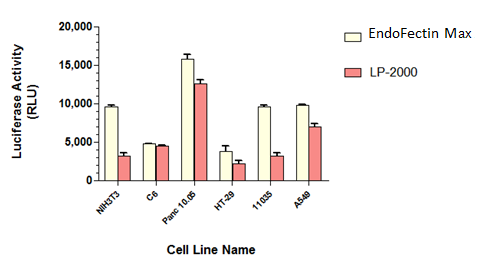 |
| B |  |
| C | 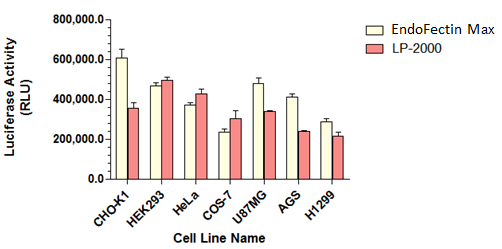 |
| Figure 2. Transfection of 17 commonly-used cell lines using either EndoFectin™ Max or Lipofectamine® 2000 (LP-2000). Cell lines with low transfection efficiency (A), medium transfection efficiency (B), and high transfection efficiency (C) were transfected with a firefly luciferase-expressing plasmid. Transfection efficiencies were assessed by luciferase activity (RLU). Lipofectamine® is a trademark of Invitrogen. | |
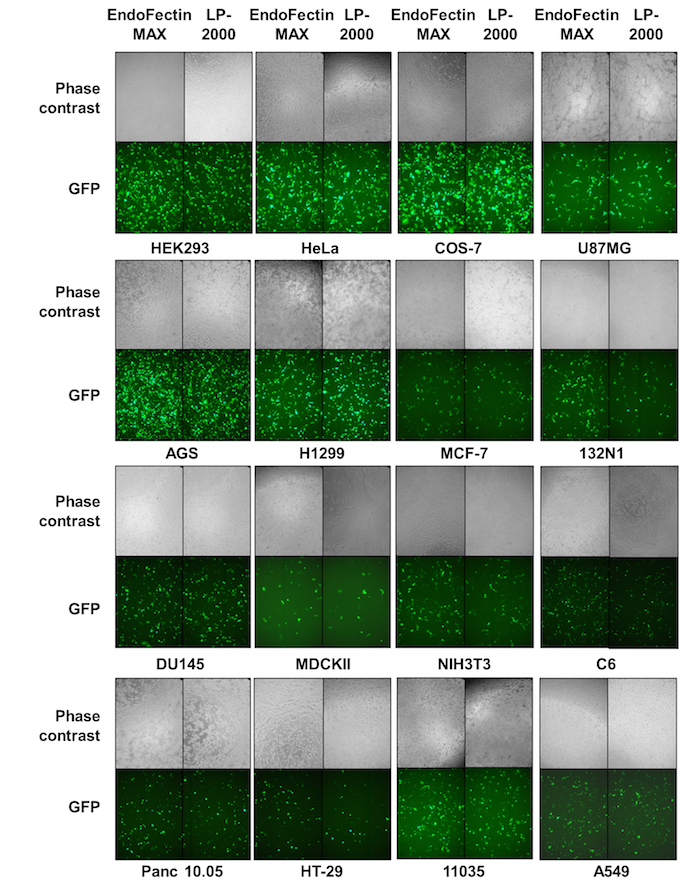 |
| Figure 3. Assessment of EndoFectin™ Max transfection efficiencies using GFP visualization. 16 commonly-used cell lines were transfected with a GFP-expressing plasmid using either EndoFectin™ Max or Lipofectamine® 2000 (LP-2000). Cells were visualized 48 hours post-transfection under phase contrast or fluorescence microscopy (GFP filter). Lipofectamine® is a trademark of Invitrogen. |
Experiment 3: Comparison of EndoFectin™ Max and Lipofectamine® 2000 in siRNA transfection
| A | B |

Figure 4. Comparison of transfection of siRNA between EndoFectin™ Max and Lipofectamine® 2000, Cell lines H1299 (A) and HEK293 (B) were transfected with either a firefly luciferase-expressing plasmid (blue bars), or co-tranfected with a firefly luciferase-expressing plasmid and an anti-luciferase siRNA (red bars). Transfection efficiencies were assessed by luciferase activity (RLU). Lipofectamine® is a trademark of Invitrogen.
Experiment 4: Comparison of EndoFectin™ Max and Lipofectamine® 2000 for cytotoxicity
 |
| Figure 5. Comparison of cytotoxicity between EndoFectin™ Max and Lipofectamine® 2000. Lipofectamine® is a trademark of Invitrogen. |
- GeneHero™ CRISPR-Cas9 clones
- OmicsLink™ Expression-Ready ORF clones
- OmicsLink™ shRNA expression clones
- GLuc-ON™ promoter reporter clones
- miTarget™ miRNA 3’UTR target clones
- miExpress™ precursor miRNA clones
- miArrest™ miRNA inhibitor clones
- Lenti-Pac™ lentiviral packaging kits
- MycoGuard™ Mycoplasma PCR Detection Kit
EndoFectin™ Lenti Transfection Reagent
EndoFectin™ Lenti is a robust transfection reagent, optimized specifically for lentiviral packaging. This cation-based transfection reagent delivers high transfection efficiency and high titer lentiviral packaging results, equal to or better than leading competitors (Figure 1).
| Buy | Catalog # | Product | Price (US$) | Protocol | MSDS |
|---|---|---|---|---|---|
| EF001 | EndoFectin™ Lenti transfection reagent (1 mL) | $255 | Download | Download | |
| EF002 | EndoFectin™ Lenti transfection reagent (3 mL) | $509 |
Figure 1. HEK293T cells were transfected with an EGFP-expressing plasmid using various transfection reagents as indicated. The cells were observed with an inverted fluorescence microscope 20 hours after transfection. HEK293T cells were transfected either in serum-free medium (A) or in 10% serum (B). Lipofectamine 2000® (LF2000) is a trademark of Invitrogen; FuGENE® is a trademark of Roche.
Related Products
- GeneHero™ CRISPR-Cas9 clones
- OmicsLink™ Expression-Ready ORF clones
- OmicsLink™ shRNA expression clones
- GLuc-ON™ promoter reporter clones
- miTarget™ miRNA 3’UTR target clones
- miExpress™ precursor miRNA clones
- miArrest™ miRNA inhibitor clones
- Lenti-Pac™ lentiviral packaging kits
- MycoGuard™ Mycoplasma PCR Detection Kit
EndoFectin™ RNAi
EndoFectin™ RNAi transfection reagent is a transfection reagent based on the principle of lipofectamine® transfection. It is specially designed to deliver siRNA and miRNA to mammalian cells. It can form a complex with nucleic acid and allow the complex to enter the cell. EndoFectin™ RNAi transfection reagent is widely applicable to common cell lines, such as HEK-293, HEK293T, Hela, NIH/3T3 and A549, etc. This reagent efficiently delivers nucleic acids into cells even in the presence of serum.Advantages
- Better transfection efficiency.
- Low cytotoxicity.
- For transfection of a variety of cell lines, easy to operate.
- Does not require removal of serum or culture medium, or removal of medium after transfection.
CRISPR-Fectin™ Transfection Reagent
CRISPR-Fectin™ is optimized lipid-based transfection reagent for CRISPR-Cas9 ribonucleoprotein delivery. Compatible with our GeneHero™ Cas9 Nuclease.Advantages
- High transfection efficiency for Cas9 nuclease and synthetic sgRNA
- Low toxicity to cells
- Cost effective with as low as $0.059 per transfection reaction
EndoFectin™ Expi293 Transfection Reagent
EndoFectin™ Expi293 is a powerful transfection reagent ideally suited for transfection of the suspension cell line Expi293F. Expi293F is the most commonly used suspension HEK293 cell line for transient expression to achieve high cell density. EndoFectin™ Expi293 provides greater transfection efficiency of Expi293 cells than Expifectamine 293 over a range of cell densities. The EndoFectin™ Expi293 kits are designed for high level of secreted (EF017 and EF018) and intracelluar (EF019 and EF020) protein expression and isolation from Expi293F cells. The kits include EndoFectin™ Expi293 transfection reagent, as well as proprietary solutions engineered to enhance protein production.
Advantages
- Specially designed for transfection of the widely-used suspension cell line Expi293F
- Greater transfection efficiency of Expi293F cells than Expifectamine™ 293 (Figure 1).
- Greater protein expression than Expifectamine™ 293 (Figure 2)
- Does not require removal of serum or culture medium, or changing of medium after transfection.
EndoFectin HepG2 Transfection Reagent
EndoFectin™ HepG2 is a new and potent reagent optimized for transfection of the difficult-to-transfect hepatocellular carcinoma cell line HepG2. EndoFectin™ HepG2 provides superior transfection efficiency of HepG2 cells compared with Lipofectamine® 3000 (Figure 1) and Lipofectamine® 2000 (Figure 2).
Advantages
- Specially formulated for the difficult-to-transfect hepatocellular carcinoma cell line HepG2
- Greater transfection efficiency of HepG2 cells compared with Lipofectamine® 3000 (Figure 1).
- Superior transfection efficiency of HepG2 cells compared to Lipofectamine® 2000 (Figure 2)
- Transfection efficiency of HepG2 cells is comparable to electroporation, allowing you to achieve ultra-high levels of transfection more conveniently (Figure 3).
- Does not require removal of serum or culture medium or removal of medium after transfection.
| Buy | Catalog # | Product | Price (US$) | Protocol | MSDS |
|---|---|---|---|---|---|
| EF005 | EndoFectin™ HepG2 transfection reagent (1 mL) | $369 | Download | Download | |
| EF006 | EndoFectin™ HepG2 transfection reagent (3 mL) | $733 |
Publications
View publications using GeneCopoeia’s transfection reagentsTestimonials
Here you will find testimonials from customers who have had success using EndoFectin™ transfection reagents in their experiments, as well as publications that cite usage of EndoFectin™. View publications
Testimonials
Testimonial #1: Cell type: TH+ (neural cells derived differentiated from induced pluripotent stem cells) Transfection reagent: EndoFectin™ Max“I tested EndoFectin Max on TH+ neural cells, which are differentiated from induced pluripotent stem cells and are hard to transfect. EndoFectin Max transfected my cells at least as well or better than Lipofectamine® 3000. EndoFectin Max is also easier to use. I transfect the cells overnight and, using other transfection methods, I risked cell loss due to lack of nutrients. This is not an issue with EndoFectin Max, because it allows me to keep my cells in complete media during the entire incubation. I will get the entire lab on board to try EndoFectin Max”.
-Gabriela Novak, University of California at San Francisco
Testimonal #2. Cell type: 10T1/2 Transfection reagent: EndoFectin™ Max“Endo Fectin max is a good transfection reagent as I compared other vendors for difficult to transfect cells. It’s less toxic to the cells. Expression of the transfected protein is comparable or slightly higher to other vendors and I recommend using Endo Fectin max”
–Amrendra K Ajay, Harvard Medical School
Testimonal #3. Cell type: Vero Transfection reagent: EndoFectin™ Max“I did use your Endofectin Max reagent several times and was quite impressed. Not having to remove the transfection mix is a nice touch. I compared it to Lipofectamine® 2000 as well as Fugene® 6 and I got about 2x transfection efficiency over each. I’m working with Vero cells which are hard to transfect.”
– Jeff Davis, Arisan Therapeutics
Testimonal #4. Cell type: HEK293 Transfection reagent: EndoFectin™ Max“HEK293 cells were transfected with either EndoFectin Max or Lipofectamine® 3000 with a luciferase-expressing plasmid. The cells transfected with EndoFectin exhibited 2-3 fold greater luminescence values over the Lipofectamine-treated cells”
–Angel Cid-Arregui, German Cancer Research Center, Heidelberg, Germany Testimonal #5. Transfection reagent: EndoFectin™ Lenti“Endofectin Lenti has enabled us at the Viral Pseudotype Unit (VPU) to dramatically increase the titres of our influenza lentiviral pseudotypes. With titres exceeding 10^9 RLU/ml we can perform large scale screening projects with a single batch of virus.”
–George Carnell, Universities of Greenwich and Kent, Kent, United Kingdom Testimonial #6: Cell type: HUVEC Transfection reagent: EndoFectin™ Max “We used EndoFectin Max on HUVEC cells. We can say that EndoFectin Max works well with this cell line relative to other transfection reagents.” -Marcin Magierowski,Jagiellonian University Medical College, Krakow, Poland Testimonial #7: Cell type: HEK293 Transfection reagent: EndoFectin™ Max “I used EndoFectin Max for HEK293 cells. It has good efficiency and low toxicity. I am regularly engineering cell lines and need a good reagent like this one.” -Janice Thomas, Oncoveda Cancer Research Center, Medical Diagnostic Laboratories, LLC Testimonial #8: Cell type: Mouse embryonic stem cells Transfection reagent: EndoFectin™ Max “We have been using EndoFectin Max for several months now for a variety of transfections (e.g. dsRNA, mRNA, plasmid DNA) in mouse ESCs (D3 cell line) and mESC-differentiated fibroblasts, and have been very pleased with our results…high efficiency and little to no toxicity. I’d definitely recommend this product to others.” -William D’Angelo, The University of Southern Mississippi Testimonial #9: Cell type: HEK293T Transfection reagent: EndoFectin™ Max “I got 65% transfection efficiency with EndoFectin Max on HEK293T cells. I would recommend this product to others.” -Hemant Raj Joshi, Graduate Student, University of Utah Testimonial #10: Cell type: Rat primary hippocampal neurons Transfection reagent: EndoFectin™ Max|
“My lab has had a chance to transfect primary hippocampal neurons with the sample you sent, and so far, it works really well! From the attached image you’ll see that the transfection might appear low…but for our imaging studies we need to see single neurons in their entirety. With too many transfectants, this becomes a problem. We typically see between 5-10% transfection rates of these cells with the sample. This is also about 10X the transfection rate compared to Lipofectamine® 2000.“ – Michael Silverman, Assoc. Professor, Simon Fraser University |
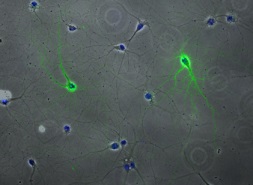 |
|||
| Rat neurons after 11 days of in vitro culture transfected with a GFP-expressing plasmid using EndoFectin™ Max (green) . Cells were visualized for fluoresence 24 hours after transfection. Blue: DAPI staining for nuclei. | ||||
 |
Want to say something about our transfection reagents? Please email us at inquiry@genecopoeia.com
We value your feedback. Please let us know
1.What kind of cells are you using?
2.What kind of challenges you are facing?
3.What are the results from using our transfection reagents?
4.Send an image from your transfection experiments.
After we receive your comments, we will send you a specially-designed thank-you gift. Please include your contact information in the email you send. |

